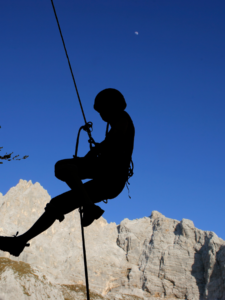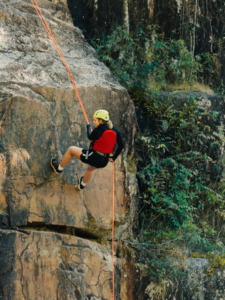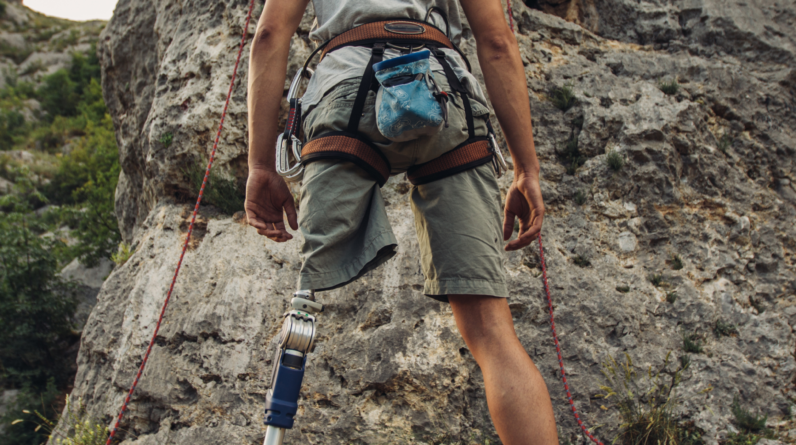
How to Cope With Fear in Climbing
The Thrill and the Fear of Climbing
The adrenaline rush, the challenge, and the connection with nature—these are all integral parts of the climbing experience. However, when fear is added to the mix, it can become an entirely different endeavor. Understanding how to cope with fear in climbing is essential for both your safety and enjoyment.
Let’s Talk About Fear: Understanding the Climber’s Mindset

Fear is a natural, instinctual response to perceived danger, and it has played a crucial role in our survival as a species. As climbers, we face many challenges that can trigger these fears—heights, falling, and the unknown, to name a few. Acknowledging fear is the first step in learning how to cope with it.
The Role of Fear in Climbing: Protection or Hindrance?
Fear can be a double-edged sword in climbing. On one hand, it can heighten our senses, making us more cautious and focused. On the other, it can hinder our performance, causing us to freeze or make impulsive decisions. Striking a balance between healthy fear and debilitating anxiety is key.
Debunking the Myth: Does Fear Mean You’re Not a Good Climber?
It’s a common misconception that fear equates to a lack of skill or experience. In reality, even the most seasoned climbers experience fear. It’s not the absence of fear that defines a good climber, but rather the ability to manage and overcome it.
Getting to Know Your Fear: The Different Types of Climbing Fears

Fear of Heights: Dizzying Heights and How to Deal With Them
-
- Acclimate yourself to heights gradually
- Focus on the task at hand, not the distance below
Fear of Falling: Overcoming the Paralysis of Gravity
Fear of Failure: Silence the Inner Critic on the Wall
-
- Recognize that failure is part of the learning process
- Embrace challenges as opportunities for growth
Fear of the Unknown: Navigating the Unpredictable Terrain
-
- Plan and prepare for the unexpected
- Embrace the excitement of new challenges and experiences
Climbing Techniques: Building Confidence Through Skill
The Importance of Proper Technique: A Foundation for Confidence
The Power of Visualization: Picturing Your Path to Success
-
- Mentally rehearse each move before attempting it
- Visualize yourself successfully completing the climb
The Art of Breathing: Calming Your Nerves on the Climb
-
- Practice deep, controlled breathing techniques
- Use breath as an anchor to maintain focus and calm
Tools and Equipment: How Gear Can Help Alleviate Fear
Trusting Your Gear: Dispelling Doubts About Safety Equipment
-
- Research and invest in quality gear
- Regularly inspect and maintain your equipment
Harnessing the Harness: Securing Yourself Against Falls
-
- Properly fit and adjust your harness
- Trust in the harness’s ability to support you
The Role of the Rope: Your Lifeline on the Rock
The Buddy System: Climbing With a Partner You Can Trust

The Role of Communication: Clarity and Understanding on the Climb
-
- Establish clear verbal and non-verbal communication
- Regularly check in with your partner throughout the climb
Building Trust With Your Partner: A Bond That Conquers Fear
- Share climbing experiences to build rapport
- Discuss expectations, fears, and concerns openly
The Safety Net: Knowing Your Partner Has Your Back
-
- Develop confidence in your partner’s abilities
- Ensure both climbers are familiar with safety protocols
Facing Your Fears: Practical Exercises to Conquer Anxiety
Taking Baby Steps: Gradually Increasing the Challenge
-
- Start with smaller, less intimidating climbs
- Incrementally progress to more difficult routes
Embracing Exposure: Overcoming the Fear of Open Spaces
-
- Climb in a variety of settings to build comfort
- Focus on the immediate environment, not the vastness around you
Practice Falls: Learning to Trust the System
-
- Perform controlled falls in a safe environment
- Increase the height and difficulty of falls as you gain confidence
When It’s More Than Just Fear: Recognizing Anxiety Disorders
Understanding the Difference: When to Seek Professional Help
-
- Be aware of symptoms that go beyond normal fear
- Consult with a mental health professional if anxiety is overwhelming
Strategies for Managing Anxiety: Beyond the Climbing Wall
-
- Employ relaxation techniques, such as meditation or yoga
- Consider therapy or support groups for additional guidance
The Psychological Toolbox: Mental Strategies for Climbers
Positive Self-Talk: Encouraging Yourself Through Tough Spots
-
- Replace negative thoughts with constructive ones
- Remind yourself of past successes and growth
The Power of Mindfulness: Staying Present on the Climb
-
- Practice being fully engaged in each moment
- Avoid dwelling on past mistakes or future obstacles
Goal Setting: Celebrating Progress and Overcoming Setbacks
-
- Set achievable, incremental goals for improvement
- Recognize and celebrate milestones, no matter how small
Conclusion: Embracing the Journey and Overcoming Fear in Climbing
The Transformative Experience: How Climbing Changes Us
Climbing offers an unparalleled opportunity for personal growth and self-discovery. As we face and conquer our fears on the rock, we learn valuable lessons about resilience, determination, and trust.






